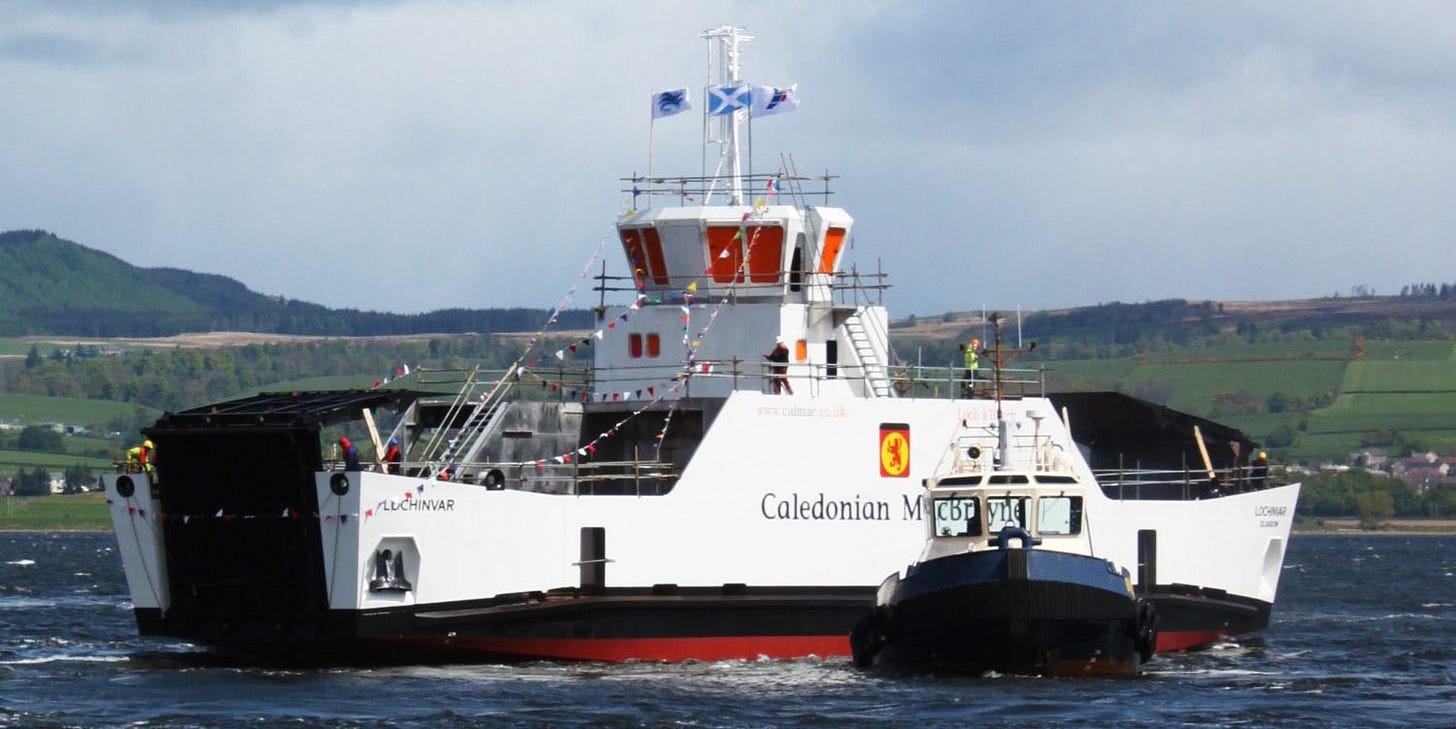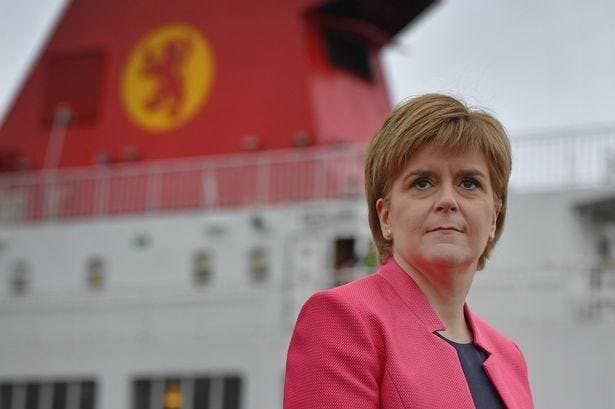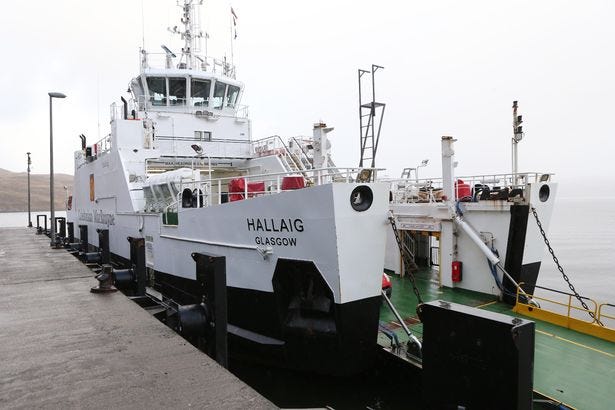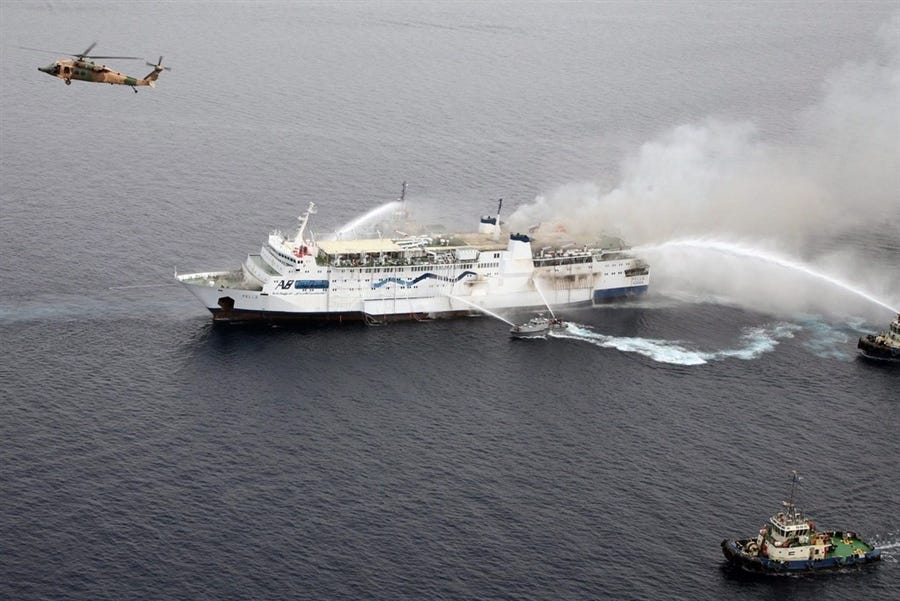Electric Ferry Boat Battery Fails: Passengers Evacuated, Green Dream Scuttled
Abandon ship !
Tucos’ Child Preface
Third electric ferry boat grounded on green dream shoals
Here I present yet another specially curated article from the Woke Accross the Pond Crowd as untold millions of Euros, GBP or whatever propped up currency are flushed down to Davy Jones Locker. Can you imagine being on a ferry boat in which there is an uncontrollable battery fire? Welcome to the The World’s First Hybrid Ferry – MV Hallaig.
Flagship hybrid ferry now only runs on diesel as battery too expensive to fix
SUNDAY MAIL EXCLUSIVE: It was hailed by the former first minister Nicola Sturgeon (what a name) as a symbol of the SNP but the MV Hallaig's electric battery can't be replaced and it will take bosses 18 months to fix it
A hybrid electric ferry hailed by Floundering Nicola Sturgeon is now only running on polluting diesel because a £1.5million battery is taking 18 months to replace. The MV Hallaig was the first in the world to use a system which cut carbon emissions by 20 per cent when it was launched in 2012.
But the battery broke on the £10million vessel in September and bosses have admitted it could be April 2025 before it’s fixed because the replacement part is no longer available.
It’s now the third problem ferry in Scotland after the controversy over the MV Glen Sannox and MV Glen Rosa which are six years overdue and £260million over budget.
Alfred Baird, formerly professor of maritime business and director of the Maritime Transport Research Group at Edinburgh Napier University, said he was consulted on the hybrid ferries but advised against them. He claims officials at the Scottish Government then complained to his bosses about his work and tried to stop his research being published.
He said: “The strategy was flawed in that it specified use of earlier battery designs that were much heavier than are now available, and operationally riskier – implying they should have continued with more efficient diesel designs until battery technology had improved sufficiently – as was the general industry practice within the ‘commercial’ ferry industry who were waiting on better technology coming along.
“The main weaknesses were therefore, one, inefficient and costly hull designs developed in-house and/or by insufficiently experienced naval architects. Two, the selection of inefficient/early battery technology which led to three higher costs of shoreside infrastructure.”
He added: “My research paper was submitted to Transport Scotland and ferry agencies at the time, also in my role as an independent Member of the Scottish Government’s Ferry Advisory Group, a Ministerial appointment. However, the officials not only ignored my advice, they complained to my university hierarchy about my research and sought to prevent publication.”
Baird’s report claimed the total running cost of the hybrid ferries would be 259 per cent more than a diesel only equivalent. Sturgeon was described as the ship’s godmother and said at the time it “symbolised everything the Scottish Government is striving to achieve”.
It was built at the now nationalised Ferguson Marine in Port Glasgow following more than £20million of Scottish government investment.
The MV Hallaig is one of three Caledonian MacBrayne hybrid ferries – the others being MV Catriona and MV Lochinvar, which have similar designs. Since its launch, Hallaig, which provides just a 25-minute service between Sconser on Skye to the small island of Raasay, has been littered with issues.
In September it was evacuated after the battery overheated and passengers had to be rescued by smaller boats, leaving around 40 visitors marooned on Skye. The MV Hallaig returned to service in October but has since been running only on diesel as costs to replace the batteries affected amount to more than £1.5million.
Dan Corrigall, who runs Stardust Boat Trips offering sailings around Skye, has had to be called in to help after issues with the MV Hallaig service has seen passengers stranded.
The 69-year-old, from Portree, said: “The government was warned about these hybrid ferries but they didn’t listen and went ahead with them anyway.
“Now we have the MV Hallaig, which cost £10million, and we’ve had nothing but issues. Islanders and tourists are really affected when there are issues. The issue with the battery and the fact the ferry is now running on diesel shows it has been a waste of time and money.”
The MV Hallaig was the first commercial ship to be launched on the River Clyde during the previous five years. The vessel is nearly 150ft long and accommodates 150 passengers, 23 cars or two heavy goods vehicles.
Scottish Labour Transport spokesman Alex Rowley MSP said: “The ever-growing list of technical failures in Scotland’s ferry fleet are a direct result of SNP incompetence. The SNP must get a grip of the mess they have made not just to deliver a national ferry building programme to modernise our lifeline ferry fleet, but to ensure they can support and maintain them in use.”
Scottish Conservative shadow transport minister Graham Simpson MSP said: “This is a relatively new ferry compared to others in the increasingly ageing fleet, so it’s somewhat embarrassing that it should be suffering such a serious issue.
“This is exactly why we need an ongoing ferry replacement programme so that we would have the resilience to deal with problems when they occur. The SNP has been letting down islanders for too long.”
Robbie Drummond, chief executive of operator CalMac, said: “MV Haillag’s technical performance up to the incident in 2023 has been exceptional, averaging over 5000 sailings per year at a reliability of 99.9 per cent.
“Delivered in 2013, the vessel is now 10 years old, with the battery originally estimated to last 10 years by the manufacturer. The battery was removed from MV Haillag after an overheating incident in September 2023, with the upgrade programme well underway.
"The replacement process is a complex one, involving the upgrade of both the battery and battery management systems, as well as ensuring it is working correctly with the onboard propulsion management systems and software. We’ve also navigated additional complications as the original battery manufacturer is no longer in business.”
A spokesman for Scottish Government body Transport Scotland said: “The order for new batteries and auxiliary systems for the MV Hallaig was placed after the incident onboard the vessel in September and the upgrade programme along with commissioning is set to be complete by quarter one 2025.”
Ferguson Marine declined to comment.










To me the telling comment from the company was .. "the original battery manufacturer is no longer in business.” this making replacement and upgrade more complicated. I image the cost is also prohibitive. With an industry like ferry's who have to be 99.9% dependable, batteries are not the best option, but the narrative wins over the sensible report.
Is it the "green" returns (tax credits) that make this so appealing, over human health and safety or just the virtue signalling?
In these Scottish waters passengers would be dead in minutes.
So the design life of the battery was 10 years, yet at the 10-year mark they didn't start looking for a replacement until the battery failed?